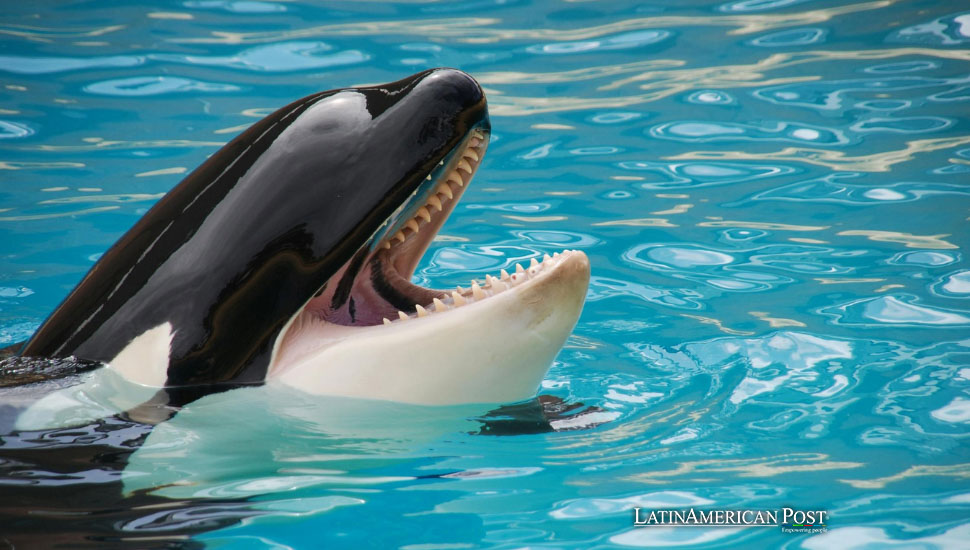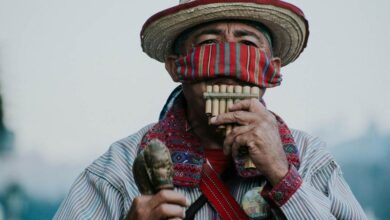Free Kshamenk: The Battle to Release Latin America’s Last Captive Orca

In the heart of Argentina, Kshamenk, the last captive orca in Latin America, lives in isolation. His story has ignited a global movement, questioning the ethics of orca captivity and demanding his release after more than 30 years.
Kshamenk: A Lonely Life in Captivity
Kshamenk has spent over three decades in a tank at the Mundo Marino oceanarium in San Clemente del Tuyú, Argentina, making him the last captive orca in Latin America. Captured in 1992, Kshamenk was initially part of a group that was allegedly stranded on the Argentine coast. However, many animal rights activists contest this story, claiming he was deliberately captured for entertainment. The loss of his female companion in 2000 has left him alone for more than 20 years, confined to a tank far smaller than his natural ocean habitat.
Recently, the orca has become a symbol of the fight against marine mammal captivity. A social media campaign led by the Canadian activist group UrgentSeas has gained global traction, drawing attention to Kshamenk’s plight through viral clips that show him barely moving in his tank. One timelapse video shared on TikTok, accompanied by the hashtag #FreeKshamenk, has garnered over 184,000 responses, reigniting the debate over whether Kshamenk should remain in captivity or be released back into the wild.
UrgentSeas told CNN that Kshamenk’s confinement is nothing short of torture. “We strongly believe socially complex animals like orcas don’t belong in captivity. Solitary confinement is the highest form of torture, and Kshamenk doesn’t deserve that,” the group stated.
However, Mundo Marino has vehemently denied the claims, stating that the videos were “maliciously manipulated” to create a false impression of Kshamenk’s health and activity levels. The oceanarium insists that the orca’s health is stable, with no veterinary evidence suggesting otherwise. The battle between activists and Mundo Marino, though, is far from new, and it is rooted in years of controversy surrounding Kshamenk’s capture and treatment.
A Global Shift: Captivity No Longer the Norm
The fight to free Kshamenk comes amid a broader global conversation about the ethics of keeping marine mammals in captivity. Across Latin America, orca shows have been phased out, and many countries have introduced stricter regulations against capturing and displaying marine mammals. Yet, Kshamenk remains.
According to the International Marine Mammal Project, only 54 orcas remain in captivity, down from 166 taken from the wild since 1961. The public’s awareness of animal rights has grown significantly, and activists argue that Kshamenk’s story is a relic of a past era where animal entertainment was seen as typical. Now, countries across Latin America have made strides in animal rights, often shutting down marine shows entirely.
However, Kshamenk’s story parallels other high-profile cases in the region. In Mexico, the story of Keiko, the orca made famous by the film Free Willy, sparked worldwide attention when activists successfully campaigned for his release. Though fraught with challenges, Keiko’s journey became a beacon of hope for animal rights activists, showing that orcas could be rehabilitated and reintroduced to the wild. In Brazil, marine parks that once held dolphins and small whales have closed their doors, acknowledging the ethical concerns surrounding marine mammal captivity.
Activists argue that Kshamenk’s situation mirrors these past cases. Despite Mundo Marino’s claims that releasing him would be dangerous, many believe that with careful planning, Kshamenk could still thrive in a marine sanctuary or even return to his natural habitat, similar to what was attempted with Keiko.
“Kshamenk has been locked up in that oceanarium, entertaining people ever since his capture,” said animal rights lawyer Mauricio Trigo. “And since 2000, he has not seen another orca,” added activist Dalila Lewis. For animal rights groups, this isolation is the greatest tragedy of Kshamenk’s captivity.
Controversy Over Kshamenk’s Capture
The origins of Kshamenk’s captivity remain a point of contention. Mundo Marino asserts that Kshamenk was rescued after being stranded with a group of orcas in 1992. However, animal rights organizations, including the NGO Marine Animal Rights, contest this version of events. According to these groups, Kshamenk’s stranding was not a rescue but rather a deliberate capture.
“They went out to look for a male orca for Belén, the female orca they had at the time. They wanted reproduction to have more orcas and create a larger show. That is the plain truth,” said María Rosa Golía, a representative of Marine Animal Rights, in an interview with CNN.
This claim has led to years of legal disputes. In 2023, several activist groups, including Marine Animal Rights, filed a lawsuit against Mundo Marino to stop its orca shows and push for Kshamenk’s release. The activists argue that Kshamenk’s captivity was based on a false pretext and that the orca has been exploited for commercial gain ever since. Mundo Marino, however, maintains that Kshamenk’s life is safer within the confines of the oceanarium. After rehabilitation, the park claims that releasing him into the wild would harm his survival.
Yet, these arguments do little to assuage the concerns of activists. With orcas being highly social animals typically living in tight-knit family groups, Kshamenk’s isolation is a significant factor in their calls for his release. According to the National Oceanic and Atmospheric Administration, orcas in the wild can live up to 90 years, and activists believe that Kshamenk still has many years left – provided he can live in a more suitable environment.
“Kshamenk has served Mundo Marino well,” UrgentSeas told CNN. “Now it’s time for them to return some dignity to his life. He doesn’t have to die alone in a concrete tank. The people of Argentina want better for him.”
Challenges of Survival in the Wild
Releasing a captive orca like Kshamenk into the wild is no simple task. While animal rights activists are passionate about setting him free, significant challenges are associated with transitioning a marine mammal that has spent decades in captivity back into its natural habitat. The case of Keiko, the famous orca from Free Willy, is a cautionary tale for those pushing for Kshamenk’s release.
Keiko’s journey toward freedom began with immense public support, and after years of captivity, he was released into the wild in 2002. However, the transition was far from smooth. Keiko struggled to reintegrate with wild orca pods and failed to develop the skills to hunt and socialize effectively. Though monitored and assisted, his ability to survive in the wild was severely compromised, and just a year after his release, Keiko passed away from pneumonia. His story highlights the hope and risks of freeing captive orcas, underscoring that freedom is not always synonymous with survival.
For Kshamenk, these risks are just as real. Having been confined to a tank since 1992, Kshamenk has not had the opportunity to hunt for food or navigate the vast, complex environment of the open ocean. Orcas are social creatures, dependent on their pods’ support and interaction. Kshamenk has been deprived of these vital connections for over two decades since the death of his only companion in 2000. His social skills may be significantly underdeveloped, putting him at risk of isolation in the wild, which could be fatal for an orca accustomed to life in captivity.
Health risks also pose a significant challenge. Orcas in captivity often develop compromised immune systems, having been sheltered from the natural pathogens present in their ocean habitats. Reintroducing Kshamenk to the wild could expose him to diseases his body is unprepared to handle, and activists acknowledge that his survival might be jeopardized without careful management.
Rehabilitation and gradual release into a marine sanctuary could offer a safer and more viable path forward for Kshamenk. Marine sanctuaries provide a controlled, semi-natural environment where the orca can adapt to a life closer to what he would have experienced in the wild without the full dangers of the open ocean. Here, Kshamenk could regain some of his instincts while being shielded from the threats that come with a complete return to the wild.
“It’s important to consider Kshamenk’s long-term well-being,” said marine biologist Dr. Andrea Suarez in an interview with CNN. “While we all want to see orcas free, we must ensure they have the best chance of survival. An abrupt release into the wild could be as cruel as captivity if it leads to an early death.”
Animal rights groups, including UrgentSeas, remain hopeful. They believe that with proper resources and support, Kshamenk could thrive in a sanctuary and eventually learn the necessary skills to live in a more natural environment. Even if he cannot be fully reintegrated into the wild, they argue that transitioning him to a sanctuary would significantly improve his quality of life, allowing him to escape the confined tank where he has spent most of his 35 years.
What’s Next for Kshamenk?
The question of Kshamenk’s future remains unresolved, as activists and Mundo Marino are locked in a battle over his fate. Animal rights organizations are pushing for his release into a specially designed marine sanctuary, similar to the efforts made for Keiko. This approach offers a more balanced solution, allowing Kshamenk to live out the rest of his days in a controlled environment that better replicates his natural habitat without the full risks of the wild.
Yet, Mundo Marino maintains that Kshamenk is safest in captivity. The oceanarium argues that releasing him into the wild could lead to severe health complications, or even death, due to his prolonged time out of his natural environment. Mundo Marino claims that Kshamenk’s survival in the wild would be fraught with challenges, not only because of his underdeveloped hunting and social skills but also due to his potential exposure to pathogens and environmental changes his body may be unable to withstand.
Despite these concerns, animal rights organizations, including UrgentSeas, are undeterred. They are committed to exploring every option for Kshamenk’s release, emphasizing the possibility of transitioning him to a marine sanctuary. Such a sanctuary would offer him a more natural and dignified existence while mitigating the dangers of an immediate release into the wild.
“Kshamenk doesn’t need to entertain people anymore,” said Golía from Marine Animal Rights. “We owe it to him to at least try to give him a life worthy of such an extraordinary creature.”
Although the logistics of creating a marine sanctuary are complex and expensive, activists believe the effort is worthwhile. They argue that Kshamenk has given years of service to the oceanarium. Now, it is time for Mundo Marino to return some dignity to his life by allowing him to live in a more natural environment, even if it remains somewhat controlled.
Also read: New Species Saved from Extinction in the Caribbean
The case of Kshamenk highlights the broader ethical concerns surrounding marine mammal captivity. While his story is unique, it echoes the struggles of orcas across the globe who have been taken from their wild habitats and forced into captivity. Whether or not Kshamenk will be given a second chance at life in a more natural environment remains to be seen. Still, the growing movement to free him is a testament to Latin America’s changing attitudes toward animal rights.




